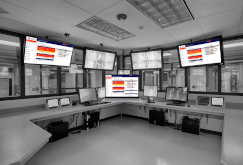JailCore’s NFC/RFID Technology
A Comparison of Inmate Tracking Systems
The best option for jail management.
There are many different types of inmate tracking systems and technology. The goal of these technologies is to streamline and modernize jail operations, but it can be difficult to know which system to choose.
Mobile inmate tracking systems often rely on the use of a handheld scanner or mobile device combined with a wristband or ID card. Barcodes and QR codes on wristbands or ID cards, however, are not ideal because they can be easily damaged (either through normal use or intentionally) and falsified. Near Field Communication/Radio-frequency Identification (NFC/RFID) technology, on the other hand, transmits data through electromagnetic radio fields, making it the most reliable option for correctional facility management.
NFC/RFID vs. QR Codes vs. Barcodes
What’s the difference, and why does it matter in your jail?
Near Field Communication (NFC/RFID)
Near Field Communication transmits data through electromagnetic radio fields to enable two devices to communicate with each other.
NFC/RFID is often used in touchless credit card payment systems such as Apple and Google Pay and Keyless Access Cards to create speed and efficiencies in transactions.
Examples of Possible NFC/RFID uses in Jails:
- Cell Identification (cell tokens)
- Inmate Identification (wristbands or ID cards)
- Secure Login into Application (key fobs)
- Inventory Control (stickers)
.
QR Codes
A machine-readable code consisting of an array of black and white squares, typically used for storing URLs or other information for reading by the camera on a smartphone.
QR codes are quite often used for marketing campaigns, business cards and product packaging to provide more information about a product.
Examples of Possible QR Code uses in Jails:
- Cell Identification (stickers)
- Inmate Identification (wristbands)
Bar Codes
A machine-readable code in the form of numbers and a pattern of parallel lines of varying widths, printed on and identifying a product.
Barcodes are generally applied to products to quickly identify them for inventory purposes.
Examples of Possible Bar Code uses in Jails:
- Cell Identification (stickers)
- Inmate Identification (wristbands)
- Inventory Control (stickers)
Near Field Communication (NFC/RFID)
Near Field Communication transmits data through electromagnetic radio fields to enable two devices to communicate with each other.
NFC/RFID is often used in touchless credit card payment systems such as Apple and Google Pay and Keyless Access Cards to create speed and efficiencies in transactions.
Examples of Possible NFC/RFID uses in Jails:
- Cell Identification (cell tokens)
- Inmate Identification (wristbands or ID cards)
- Secure Login into Application (key fobs)
- Inventory Control (stickers)
QR Codes
A machine-readable code consisting of an array of black and white squares, typically used for storing URLs or other information for reading by the camera on a smartphone.
QR codes are quite often used for marketing campaigns, business cards and product packaging to provide more information about a product.
Examples of Possible QR Code uses in Jails:
- Cell Identification (stickers)
- Inmate Identification (wristbands)
Bar Codes
A machine-readable code in the form of numbers and a pattern of parallel lines of varying widths, printed on and identifying a product.
Barcodes are generally applied to products to quickly identify them for inventory purposes.
Examples of Possible Bar Code uses in Jails:
- Cell Identification (stickers)
- Inmate Identification (wristbands)
- Inventory Control (stickers)
Why you should never use QR or Bar Codes in your jail.
Physical Damage
NFC’s Solution
NFC/RFID tags (on inmates or cells) electronically store a cell/inmate name and that name is being read by the mobile device’s NFC/RFID reader. External blemishes will never affect an NFC/RFID token’s readability.
How to Make a QR or Barcode Unreadable
- Take any object that has a sharp point.
- Scratch it along the surface of the QR or Barcode.
Congratulations, you’ve successfully ruined your QR or Barcode.
Falsifying Scans
NFC’s Solution
Because NFC/RFID is NOT photo readable technology, this CANNOT happen. To falsify NFC/RFID, a CO would have to be able to program a cell token or inmate tag. Since there are permissions granted as to which officers have the ability to electronically program these NFC/RFID tags, there is a higher level of security that they cannot be falsified.
How to Copy and Fake a QR or Barcode
- Snap a photo of the QR or Barcode with your personal cell phone.
- Print the photo of the QR/Barcode or save it as an image on your phone.
- With the Jail’s device, scan the photocopy of the QR/Barcode or hover it over the saved image.
That’s it! You have created a copy and spoofed the QR or Barcode.




